Most native pollinator plants begin blooming in late March and continue providing nectar and pollen throughout the summer. Scroll below to view pictures of each blooming native.
Here is quick alphabetical listing of spring and summer blooming pollinators:
- Black-Eyed Susan
- Blue Mist Flower
- Butterfly Milkweed
- Fall Obedient Plant
- Green Milkweed
- Gulf Coast Penstemon
- Heath Aster
- Horsemint (Lemon Bee Balm)
- Indian Blanket / Firewheel
- Lanceleaf Coreopsis
- Low Ruellia/Wild Petunia
- Lyreleaf Sage
- Mealy Blue Sage
- Mexican Hat
- Partridge Pea
- Pineywoods/Pale Purple Coneflower
- Pink Primrose
- Plains Coreopsis
- Prairie Verbena
- Purple Coneflower
- Rough Coneflower
- Scarlet Sage/Red Salivia
- Small Bluebell Gentian
- Spring (Marsh) Obedient Plant
- Swamp Milkweed
- Texas Frogfruit
- Turk’s Cap
- Winecup

Butterfly Milkweed
Asclepius tuberosa
Provides nectar to butterflies, native and non-native bees and hummingbirds
Larval host to Monarch, Queen and Grey Hairstreak butterflies
Blooms April to September
For more information on Butterfly Milkweed: https://www.npsot.org/posts/native-plant/asclepias-tuberosa/

Swamp Milkweed
Asclepias incarnata
Provides nectar for butterflies, bees and hummingbirds
Larval host to Queen and Monarch butterflies
Blooms June to October
For more information on Swamp Milkweed: https://www.npsot.org/posts/native-plant/asclepias-incarnata/
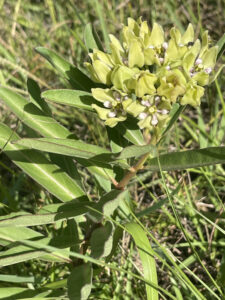
Green Milkweed
Asclepsis viridis
Provides nectar to butterflies, moths and native and non-native bees
Larval host to Monarch and Queen butterflies
Blooms April to September
For more information on Green Milkweed: https://www.npsot.org/posts/native-plant/asclepias-viridis/

Winecup
Callirhoe involucrata
Provides nectar to butterflies and bees
Larval host plant to Gray Hairstreak and Painted Lady butterfly
Blooms February to June
For more information on Winecup: https://www.npsot.org/posts/native-plant/callirhoe-involucrata/

Partridge Pea
Chamaecrista fasciculata
Provides nectar and pollen to butterflies and bees
Larval host plant to Cloudless Giant Sulphur, Orange Sulphur, and Sleepy Orange
A seed source for birds
Blooms mainly June through October
For more information on Partridge Pea: https://www.npsot.org/posts/native-plant/chamaecrista-fasciculata/
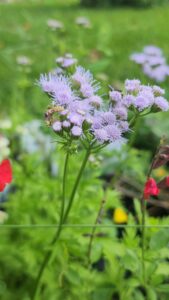
Blue Mist Flower
Conoclinium coelestinum
Provides nectar to butterflies and bees
Blooms April to December
For more information on Blue Mist Flower: https://www.npsot.org/posts/native-plant/conoclinium-coelestinum/
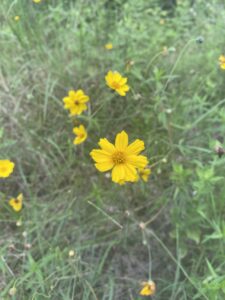
Lanceleaf Coreopsis
Coreopsis lanceolata
Provides nectar to butterflies, bees, and insect pollinators
A seed source for birds
Blooms mainly April to June
For more information on Lanceleaf Coreopsis: https://www.npsot.org/posts/native-plant/coreopsis-lanceolata/
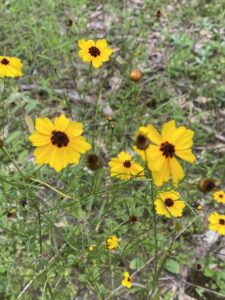
Plains Coreopsis
Coreopsis tinctoria
Provides nectar to butterflies, bees and insect pollinators
A seed source for birds
Blooms mainly April to October (Can bloom all year)
For more information on Plains Coreopsis: https://www.npsot.org/posts/native-plant/coreopsis-tinctoria/

Pineywoods/Pale Purple Coneflower
Echinacea pallida
Provides nectar to butterflies, bees and small mammals
A seed source for birds
Blooms April to June
For more information on Pale Purple Coneflower: https://www.npsot.org/posts/native-plant/echinacea-pallida/
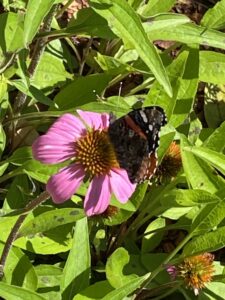
Purple Coneflower
Echinacea purpurea
Provides nectar to butterflies, bees and hummingbirds
A seed source for birds
Blooms April to August
For more information on Purple Coneflower: https://www.npsot.org/posts/native-plant/echinacea-purpurea/
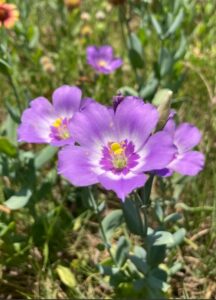
Small Bluebell (Seaside Gentian)
Eustoma exaltatum
Provides nectar for butterflies, hummingbirds and bees
Seed source for birds
Blooms June to September
For more information on Small Bluebell: https://www.npsot.org/posts/native-plant/eustoma-exaltatum/
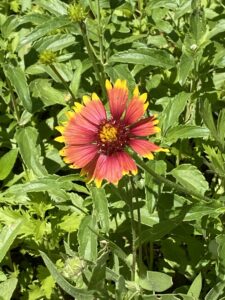
Indian Blanket / Firewheel
Gaillardia pulchella
Provides nectar to butterflies and bees
Blooms April to frost
For more information on Firewheel (Indian Blanket): https://www.npsot.org/posts/native-plant/gaillardia-pulchella/
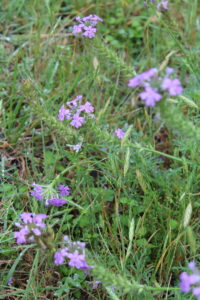
Prairie Verbena
Glandularia bipinnatifida
Provides nectar to butterflies, bees and other nectar insects
A seed source for birds
Blooms March to frost
For more information on Prairie Verbena: https://www.npsot.org/posts/native-plant/glandularia-bipinnatifida/

Turk’s Cap
Malvaviscus arboreus
Provides nectar to butterflies, hummingbirds, and bees
Larval host plant to Skippers and Scrub Hairstreak
Blooms April to frost
For more information on Turk’s Cap: https://www.npsot.org/posts/native-plant/malvaviscus-arboreus-var-drummondii/
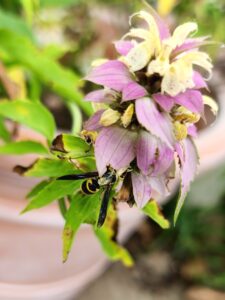
Horsemint (Lemon Bee Balm)
Monarda citriodora
Provides nectar to butterflies, native bees, hummingbirds and nectar insects
Larval host to Spicebush Swallowtail.
Blooms May to July
For more information on Horsemint (Lemon Bee Balm): https://www.npsot.org/posts/native-plant/monarda-citriodora/
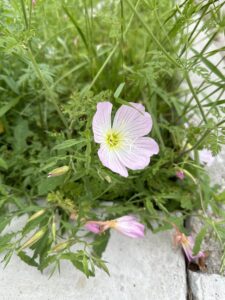
Pink Primrose
Oenothera speciosa
Provides nectar for butterflies and bees
Seed source for birds and small mammals
Blooms March to July
For more information on Pink Primrose: https://www.npsot.org/posts/native-plant/oenothera-speciosa/
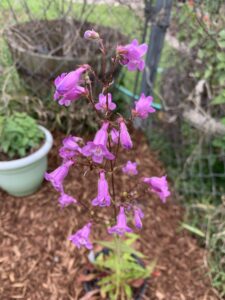
Gulf Coast Penstemon
Penstemon tenuis
Provides nectar to butterflies, hummingbirds, bees and nectar insects
Blooms May to June
For more information on Gulf Coast Penstemon: https://www.npsot.org/posts/native-plant/penstemon-tenuis/
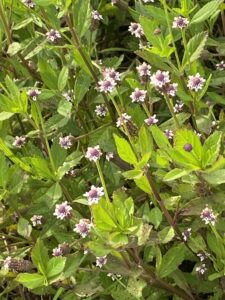
Texas Frogfruit
Phyla nodiflora
Provides nectar to butterflies and nectar insects
Larval Host to Buckeye, Phaon Crescentspot, Buckeye and White Peacock butterflies
Blooms May to November
For more information on Frogfruit: https://www.npsot.org/posts/native-plant/phyla-nodiflora/
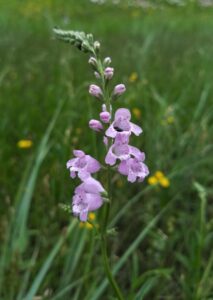
Spring (Marsh) Obedient Plant
Physostegia intermedia
Provides nectar to butterflies, hummingbirds, bees and nectar insects
Blooms April to July
For more information of Spring Obedient Plant: https://www.npsot.org/posts/native-plant/physostegia-intermedia/
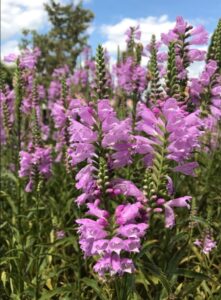
Fall Obedient Plant
Physostegia virginiana
Provides nectar to butterflies and hummingbirds
Blooms August to October
For more information of Fall Obedient Plant: https://www.npsot.org/posts/native-plant/physostegia-virginiana/
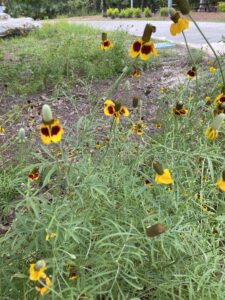
Mexican Hat
Ratibida columnifera
Provides nectar to butterflies, bees and nectar insects
A seed source for birds
Blooms May to October
For more information of Mexican Hat: https://www.npsot.org/posts/native-plant/ratibida-columnifera/

Rough Coneflower
Rudbeckia grandiflora
Provides nectar to butterflies, native bees and beetles
A seed source for birds and a leaf source for deer
Blooms April to August
For more information of Rough Coneflower: https://www.npsot.org/posts/native-plant/rudbeckia-grandiflora/
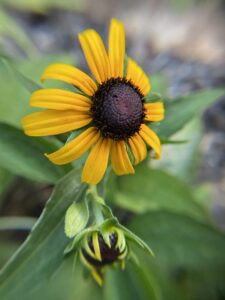
Black-Eyed Susan
Rudbeckia hirta
Provides nectar to butterflies, bees and nectar insects
Larval host for Gorgone Checkerspot and Bordered Patch
A seed source for birds
Blooms May to November
For more information of Black-Eyed Susan: https://www.npsot.org/posts/native–plant/rudbeckia-hirta/
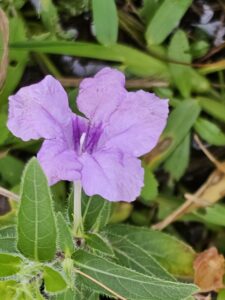
Low Ruellia/Wild Petunia
Ruellia humilis
Provides nectar to butterflies, moths, hummingbirds and bees
Larval host to Buckeye and Common Wood Nymph
Blooms May to September
For more information of Low Ruellia/Wild Petunia: https://www.npsot.org/posts/native-plant/ruellia-humilis/
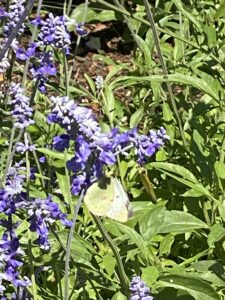
Mealy Blue Sage
Salvia farinacea
Provides nectar to butterflies, hummingbirds, and bees
A seed source for birds
Blooms April to frost
For more information on Mealy Blue Sage: https://www.npsot.org/posts/native-plant/salvia-farinacea/
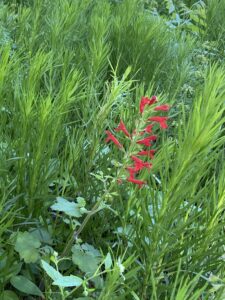
Scarlet Sage/Red Salvia
Salvia coccinea
Provides nectar to butterflies, hummingbirds and bees
Blooms February to October
For more information on Scarlet Sage: https://www.npsot.org/posts/native-plant/salvia-coccinea/
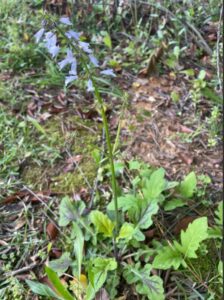
Lyreleaf Sage
Salvia lyrata
Provides nectar to butterflies, bees and hummingbirds
Native bees will overwinter in stems
Blooms March to June
For more information of Lyre Leaf Sage: https://www.npsot.org/posts/native-plant/salvia-lyrata/

Heath Aster
Symphyotrichum ericoides
Provides nectar for butterflies, moths and native bees
Larval host for Pearl Crescent butterfly and the Wavy-Lined Emerald moth
Blooms September to November
For more information on Heath Aster: https://www.npsot.org/posts/native-plant/symphyotrichum-ericoides/


